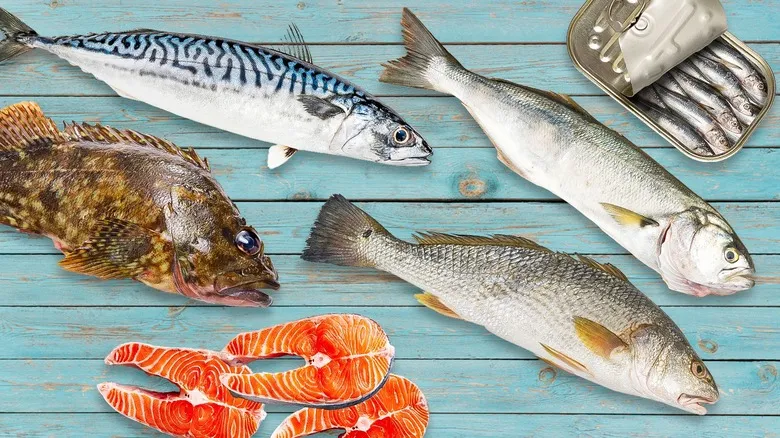Bluefish
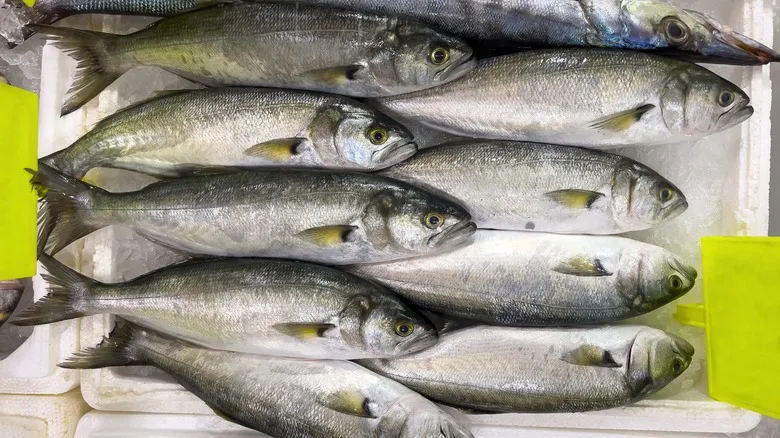
Just as you can save money at the grocery store by opting for store brands instead of name brands, you can also find savings at the fish market by choosing lesser-known fish varieties. One such fish that Eli Kirshtein appreciates is bluefish. Along with other underrated options, bluefish, as Kirshtein noted, "provides excellent value since they are not as popular as their more expensive counterparts like salmon, halibut, and tuna. While they may not be well-known, they are by no means inferior."
Bluefish is a firm fish with a slightly darker and richer profile compared to typical white fish, and it cooks up in large flakes. Its richness and bold flavor might be too intense for some, but its strong character pairs well with robust accompaniments like aioli, a Vietnamese-style caramel sauce, or a mustard sauce. It's certainly a fish for enthusiasts, so if you consider yourself a fan, be sure to seek out bluefish during the summer months when they are most plentiful.
Mackerel
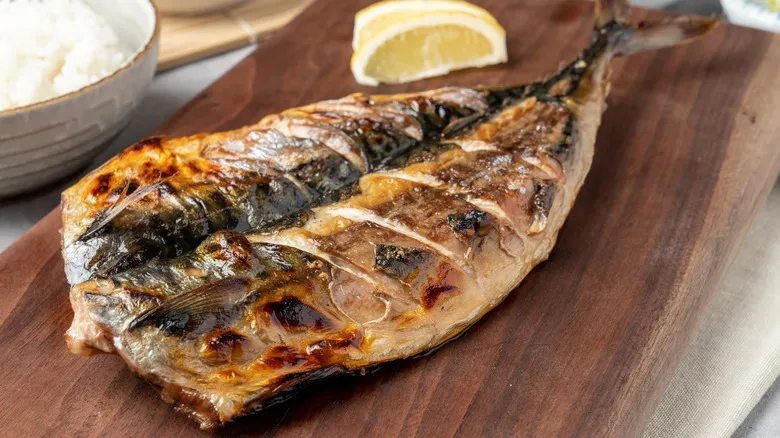
If you enjoy fish with bold flavors, be on the lookout for fresh mackerel. Not only are they packed with flavor, but they can also be quite budget-friendly. "When mackerel are plentiful in the spring and fall, they become a relatively inexpensive option," Carl Fantasia noted. "They're very affordable," he added. "We're offering them at $6.99 per pound whole, and we can prepare them however you like, including filleting if you prefer."
Mackerel, similar to bluefish, have a higher oil and fat content compared to milder fish, resulting in a more pronounced and robust flavor. Because of this, Fantasia suggests grilling or broiling them. "I like to use really high heat," he mentioned. To complement and balance their richness, he recommends pairing mackerel with a bold sauce, such as a lemon-parsley sauce, a Japanese-style ponzu sauce with yuzu juice, or a zesty sauce enhanced with ginger and scallions.
Drum

Indeed, "drum" refers to both a type of fish and a percussion instrument. According to Eli Kirshtein, if you're looking for a flavorful yet budget-friendly fish, drum is definitely worth considering. This mild, firm white fish responds well to simple seasonings and cooking techniques. Kirshtein suggests, "For a healthy choice, try baking it in parchment paper with vegetables and olive oil for a convenient one-pan meal." He adds, "It's also delightful when grilled or pan-seared with a basic butter sauce."
This often-overlooked fish has an interesting name: species in the drum family, which includes both freshwater and saltwater varieties, are recognized for their loud, drum-like sounds produced by muscle vibrations against their swim bladders. While commercial fishermen have historically regarded drum as undesirable bycatch—possibly contributing to its affordability—recreational anglers view drum as worthy challengers and a delicious reward after a long day of fishing.
Skate wing

When searching for budget-friendly fish options, it’s beneficial to venture off the usual path. A variety you may have never thought to try could quickly become your new favorite. Take skate wing, for instance – the meaty fins of certain ray species – which is a popular delicacy in France but remains relatively unknown in the U.S. Although a skate may not resemble a typical fish, either in the water or on your plate (its wings contain long, thin cartilage instead of bones), its firm, flavorful white meat is sure to please any fish enthusiast. "It's one of those lesser-known fish species that those who aren't well-informed might overlook, but it can save you some money," said Carl Fantasia.
So, how should you prepare skate wings if you’re fortunate enough to find them? A classic French method involves serving them with a sauce made from brown butter (butter that has been heated until it begins to toast and darken). You can enhance the sauce with additional flavors like white wine and/or capers.
Farmed grouper

Sustainably farmed fish can be a great choice if you're looking to save money. "Farmed grouper is an excellent option that many people tend to overlook," stated Charlie Siebenberg. "It's sustainable, budget-friendly, and widely available." Plus, it's quite tasty. "Farmed grouper features a mild, slightly sweet taste and a firm, flaky texture, making it a versatile substitute for more popular fish like salmon or wild snapper," Siebenberg noted.
Due to its subtle flavor, high-quality grouper doesn't require much enhancement – the best cooking techniques highlight its natural taste. Additionally, these methods are simple to execute at home. "I strongly recommend pan-searing our ASC [Aquaculture Stewardship Council]-certified farmed grouper," Siebenberg advised. "A straightforward preparation involves marinating the fillets in olive oil, lemon juice, and herbs, then finishing them in the oven until just cooked through. This approach preserves the fish's inherent sweetness and results in a healthy, delicious meal."
Hawaiian kanpachi
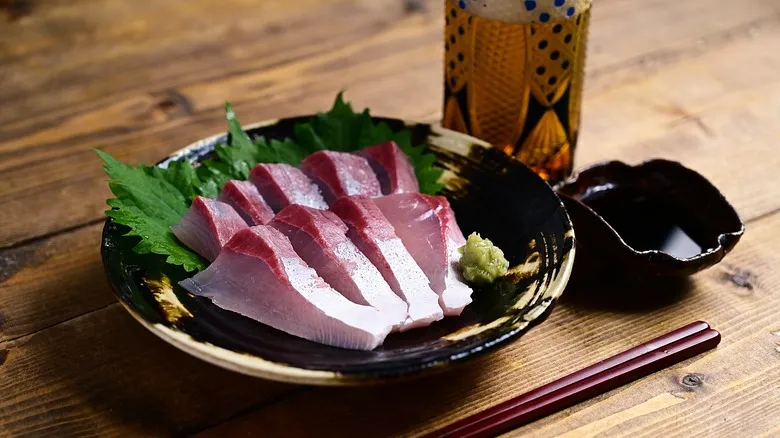
If you're looking for seafood that balances sustainability and affordability, farmed Hawaiian kanpachi is an excellent option. "Sustainably farmed fish like Hawaiian kanpachi are generally more cost-effective than wild species such as salmon or tuna," explained Vitaly Paley. "Its pricing is also very stable, making it easier to plan your budget. Additionally, the supply of sustainably farmed fish is much more consistent throughout the year, as it is cultivated rather than caught."
Moreover, kanpachi is delicious and versatile, so you won't feel like you're compromising on flavor. "Whether served raw or cooked, it's truly impressive," Paley noted, highlighting that the fish's firm, pink flesh is suitable for a variety of cooking methods—or even enjoyed raw. "It's fantastic in sashimi, sushi, ceviche, poke, or any raw fish dish. When cooked, it’s buttery, mild, and simply delightful. Its natural fat content is clean and light, with a firm, flaky texture and subtle flavor." Due to its richness, Paley adds that kanpachi pairs well with bold flavors, making it a fantastic choice for spicy fish tacos or a fish sandwich.
Rockfish

Dedicated food enthusiasts understand that lesser-known ingredients, ranging from wines and cheeses to fruits and vegetables, can be just as delightful—if not more so—than their more popular counterparts. This principle also applies to fish: unfamiliar varieties can not only be incredibly tasty but are often available at a more budget-friendly price. For example, Jeff Josenhans recommends west coast rockfish. "There are numerous types of groundfish found off the Pacific coast that are not only delicious but also sustainably managed," he noted.
Based in San Diego, Josenhans has easy access to rockfish right in his backyard. These small, robust fish inhabit shallow waters and, as their name suggests, prefer oyster reefs and rocky environments. "In general, rockfish have a white, somewhat firm, flaky texture, though this can vary by species," Josenhans explained. "There are nearly 100 different species along the west coast, and I encourage you to sample as many as possible. If you come across a label that simply states 'rockfish,' be sure to inquire about the specific type you’re buying." He emphasizes that their rich flavor requires only minimal seasoning. "I enjoy my rockfish pan-fried in butter, accompanied by fresh herbs and potatoes, perhaps with a pan sauce featuring capers and lemon. Quality fish doesn’t need much to shine," he said.
Tinned fish
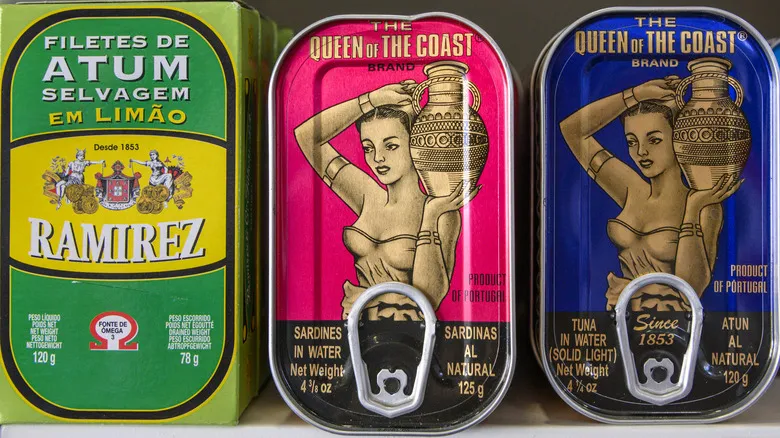
Certainly! Here’s a rewritten version of the text:
We understand that you likely have a can of tuna stashed away in your pantry. However, today’s canned seafood is much more than just a quick lunch option; it can also serve as an impressive dish that won’t break the bank. "In recent years, the U.S. has seen a rise in the popularity of tinned fish, or conservas, particularly varieties from Spain and Portugal," noted Jared Garner. These cans contain sustainably sourced seafood that is hand-packed and enhanced with unique flavorings like escabeche sauce (a vinegar-based marinade) or spiced olive oil. While they may be more expensive than standard supermarket tuna, these gourmet options can elevate a charcuterie board or serve as delightful appetizers for special occasions.
Supermarkets also provide some excellent selections of canned fish. "If you're in search of budget-friendly protein that can be prepared quickly, check out the sales in the grocery aisle and give something new a try," Garner advised. "If the appearance of what you find isn’t appealing, you can easily disguise it with delicious kimchi, fresh vegetables, and other toppings in a rice bowl to create a fantastic flavor combination." For those willing to spend a little more for higher quality at the grocery store, Garner suggests Tonnino tuna in glass jars and Bela sardines. He also recommends the smoked trout and lightly smoked salmon from Trader Joe's, both of which deliver great taste at a reasonable price.
Hake
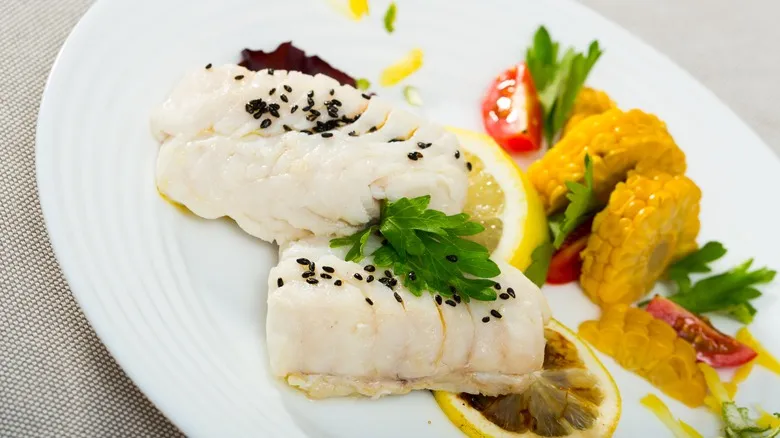
As the saying goes, there are plenty of fish in the sea—and among them, you might find a more budget-friendly alternative to your favorite special-occasion fish. For example, if you enjoy firm, white fish like cod or haddock, Carl Fantasia suggests considering hake as a cost-effective option. However, you may need to look for it at a specialty seafood market, as "many of the larger stores won't stock it," Fantasia noted.
If you're concerned that hake's lower price indicates it's inferior to cod or haddock, Fantasia provides some context: While hake is relatively unknown and thus cheaper in the U.S., it's quite popular in other parts of the world. "In Spain, for instance, it's more expensive," he explained. "They are very familiar with that fish."
Pollock

When it comes to delicious fish, appearance isn't everything. While well-known types like cod and salmon are celebrated for their vibrant colors—pure white or rich pink—other, less visually striking fish can be just as tasty and often more budget-friendly. One such option, recommended by Carl Fantasia, is pollock. "It's light white and flaky, but it has a slightly darker, pinkish-gray flesh compared to haddock or cod," he explained. "Some people might be put off by that."
However, if you can overlook the color, you can savor flavorful fish at a much lower price than the more popular varieties. "You can find fillets at a reputable fish market for under $12 a pound," Fantasia noted. "In contrast, cod, which is in higher demand and more overfished, can range from $15 to $20 a pound for skinless fillets." If you have a favorite cod recipe, you can substitute pollock, but keep in mind that pollock has a more delicate texture and may break apart more easily.
Fish collars

For those who are eager for salmon or another popular yet expensive fish, a wise choice is to explore less common cuts. While many opt for the attractive, tidy fillets, there is still plenty of fish left after the fillets are removed—and some of these leftover pieces are truly delicious. "We sell the collars of the salmon, which are located just behind the head where the two fins are attached," Carl Fantasia explained. "However, the collar does contain a bone. The flesh is incredibly delicate and tender, though you should be cautious of a few small bones. It's also significantly more affordable than salmon fillets."
Jeff Josenhans concurs. "Collars are an excellent and budget-friendly cut that often gets overlooked, but they can make a fantastic appetizer," he noted. Fantasia also shared some cooking tips: "Sear them well because they have a higher fat content, and I believe that fatty foods perform better with higher heat."
Salmon steaks
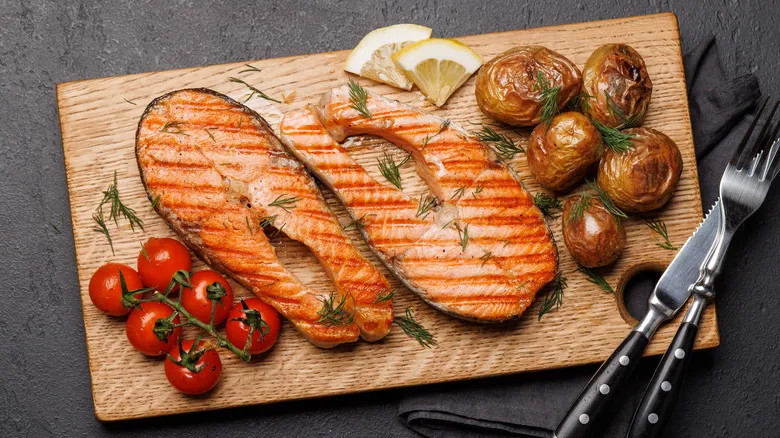
An alternative way to save money while enjoying larger fish is to opt for steaks instead of fillets. "Salmon steaks, particularly bone-in ones, are more commonly found in supermarkets than collars, and I believe they are generally more affordable," Fantasia noted. He clarified that in the seafood industry, the term "steak" refers to cross-sectional cuts from the fish's body that include the skin, spine, and other bones. "I find them to be more flavorful when grilled or baked."
Additionally, Fantasia mentioned that salmon steaks maintain their structure well, making them an excellent option for grilling. The bones and skin help keep the steaks intact, preventing them from flaking or breaking apart when turned. While some diners might consider these parts unappealing, they add significant flavor, making salmon steaks a delight for true fish enthusiasts. Grilled salmon steaks pair beautifully with a variety of seasonings, from Italian herbs to maple glazes to creamy mustard sauces.
Fish bellies

If you enjoy sushi topped with toro – the luxurious, melt-in-your-mouth fatty tuna belly – you'll be pleased to learn that these tender, rich fish bellies can often be quite affordable. Traditionally, belly strips were the leftover edges after the more desirable fillets were cut from the fish. So when you purchase belly strips, you won't get the plump, attractive fillets or steaks, but rather thin, irregularly shaped pieces of fish. They may appear to be scraps, but don’t let their unassuming appearance fool you — they are packed with flavor. "Sometimes we offer what are known as belly strips, which are the edges of the belly that contain some connective tissue, but once you roast them, they become incredibly tender," said Carl Fantasia. Jeff Josenhans also appreciates fish bellies. "While many are familiar with tuna belly, other larger fish species also have fatty, flavorful belly meat that’s definitely worth trying!" he noted.
So, once you've sourced some quality fish bellies, how should you cook them? The simple answer is: any way you prefer. They are surprisingly versatile and can be delicious when glazed with teriyaki sauce, simmered in soup, or fried tempura-style. They also lend themselves well to smoking on a grill or incorporating into ceviche.
Bonus tips and smart ways to shop for fish
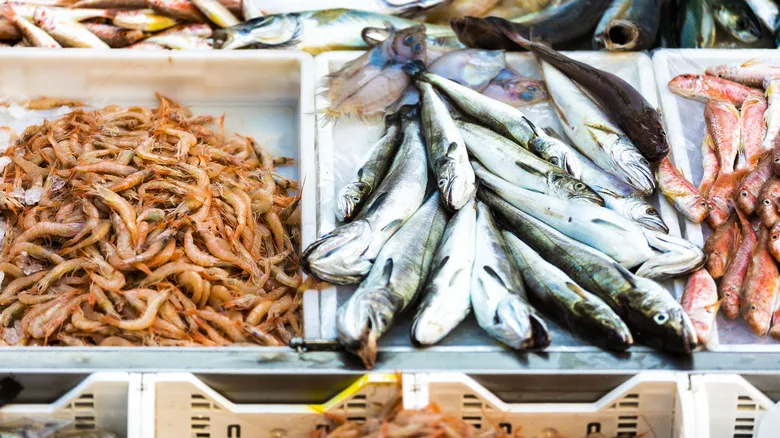
Our specialists also provided some valuable advice for budget-friendly fish shopping. Carl Fantasia and Jeff Josenhans both emphasized that unusually low prices should raise concerns for consumers. "I like to say if it seems too good to be true, it probably is," Fantasia remarked. "You should be cautious about that." Similarly, Josenhans cautioned that bargain-priced fish can often lead to disappointment, particularly if it’s not sourced locally. "Any inexpensive fish that has traveled far, like southeast Asian farmed tilapia, is generally best avoided," he noted.
On the other hand, Josenhans pointed out that your chances of finding high-quality, fresh fish at reasonable prices are greatest when buying close to the source. "Fish markets or direct purchases from fishermen or receiving locations are always the best options for buying fish," he stated. Eli Kirshtein added another tip: "Don’t overlook your local, internationally-oriented markets. They often source from the same suppliers as larger retailers and provide a wider range of customizable options," he explained.
Lastly, to ensure the long-term availability and affordability of high-quality fish, Vitaly Paley recommends that consumers prioritize sustainable choices. "I suggest making it a habit to consult the Aquaculture Stewardship Council for all farmed fish and seafood, the Marine Stewardship Council for wild-caught seafood, and the Monterey Bay Aquarium Seafood Watch for comprehensive guidance on making informed decisions about which fish or seafood is safe to purchase," Paley advised.
Recommended

Sam's Club Vs Costco: Who Has The Best Food Court?

Select Costcos Have Begun The Highly Anticipated Switch From Pepsi To Coke

The Enviable Canadian Costco Food Court Menu Items That Make Americans Jealous

13 Grocery Shopping Mistakes You Don't Realize You're Making
Next up

